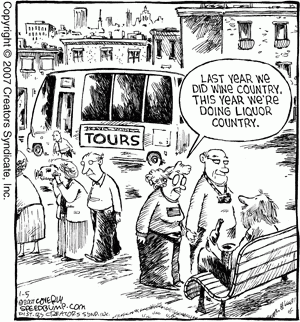Alky

Speed Bump by Dave Coverly, 1/5/2007
I had a long letter to the editor in the Washington City Paper about alcoholic beverages and how their sale is regulated. See "City on the Drink."
In short I think that Class A and B establishments (package sales) should be regulated differently and more stringently from neighborhood oriented restaurants (and taverns) and those located in mixed-use commercial districts, and that nightclub oriented places need a different level of regulation as well.
Just so people know my position: I have no problem if you want to get totally s******, just don't do it in the public spaces, throwing your empties out on the street, harassing people, and urinating in public.
OTOH, people who drink in public tend to not see the difference between their activity on street corners vs. people drinking on a restaurant patio in the public space. The difference of course has to do with personal behavior management...
Because singles tend to be consumed in ways that have extranormal negative impacts, extranormal regulatory means are required. (Note that ANC6A is pushing for a moratorium on single sales on the 700-1400 blocks of H Street. Check out their website for details.)
As far as the recent outcry over the tragic murder of a 17 year old girl at a nightclub on the 1700 block of 9th Street NW, I do think that while all-ages facilities are desirable, it is reasonable to restrict the presence of minors in adult establishments--not so much to limit their ability to be entertained but to protect them from the predatory behaviors of others.
See:
-- the Police Department press release Homicide Inside 1919 9th Street, NW
-- "D.C. Teen Is Killed at U Street Area Nightclub" subtitled "Victim, a Bystander, Is Shot in Scuffle" from the Post
-- "Nightclub Shooting May Beget Legislation" subtitled "Bill Would Restrict Minors' Presence" from the Post
-- and finally, "D.C. Police Say They Know Club Suspect's Nickname," also from the Post
For now, maybe have all ages events that have to end before 9 pm. On the other hand, as events from the Market Inn show from this past summer, it's not about the time of the event, but the propensity of violence amonst the attendees. See this Post article, "Pulse of Go-Go, Promise of Peace Mingle at D.C. Dance Event for Youth."
There's been some good discussion of this issue on the Columbia_Heights yahoogroup. People say that a limitation unduly restricts places to do all ages shows, and someone pointed out that the kinds of problems associated with go go and all ages shows don't appear to be experienced at different clubs and different music genres. Maybe it's in part management. (I think it also has to do with target audiences and a propensity or at least willingness to express violence, and the way this breaks out amongst the various demo- and psycho-graphics of music goers. See Elijah Anderson's Code of the Street for an extended discussion of my point.)
Index Keywords: public-safety; quality-of-life-advocacy



0 Comments:
Post a Comment
<< Home